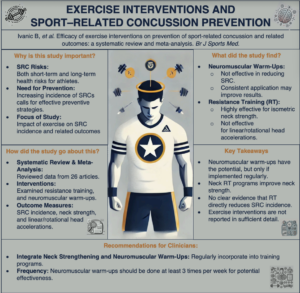Author: Branimir Ivanic | Email: branimir.ivanic@med.lu.se | LinkedIn: www.linkedin.com/in/branimir-ivanic-38900b327 | X: @IvanicBranimir
Why is this study important?
Sport-related concussions (SRCs) pose significant health risks for athletes, with both short-term and long-term consequences (1). With the rising incidence of SRCs, it is essential to explore preventive strategies that may help reduce their occurrence (2). This study systematically reviews and analyzes the potential of exercise interventions, particularly focusing on their impact on isometric neck strength, head accelerations, and ultimately, the prevention of SRC.
How did the study go about this?
The study performed a systematic review and meta-analysis to evaluate the efficacy of exercise interventions in preventing SRCs. Specifically, it looked at how different types of resistance training (RT) and neuromuscular warm-ups impact SRC incidence, isometric neck strength (the ability to hold the neck steady against force), and both linear and rotational head accelerations (how fast the head moves forward or rotates during impacts). Data from 26 articles were reviewed, assessing athletes of various sports, ages, and sexes. The interventions were examined to determine their effect sizes and reporting quality based on the Consensus on Exercise Reporting Template (CERT).
What did the study find?
The study found that, overall, neuromuscular warm-up programs did not significantly reduce SRC incidence. While there was a possible 31% reduction in risk, the results were not strong enough to confirm a clear benefit. Although these programs included neck-strengthening exercises, the overall impact on preventing SRC was limited. However, the study noted that more frequent implementation of these programs, such as incorporating them at least three times a week, could potentially lead to higher effect sizes and better results. This suggests that consistent application may be key to unlocking their full potential in SRC prevention.
On the other hand, RT was highly effective in increasing isometric neck strength, a factor associated with reduced head movement during impacts. RT programs, especially dynamic and multimodal approaches, showed large effect sizes in enhancing neck strength, particularly among males and adults. However, RT was not found to be effective in reducing linear or rotational head accelerations, potentially due to a lack of sufficient studies. This suggests that more research is needed to determine whether neck RT can decrease head acceleration and ultimately reduce the risk of SRC.
What are the key take-home points?
-
Resistance Training Helps Neck Strength: RT, particularly dynamic and multimodal programs, can significantly improve isometric neck strength, which may help reduce head movement and acceleration during impact.
-
Unclear Impact on SRC Prevention: While improving neck strength is promising, there is still no clear evidence that these interventions directly lower SRC incidence.
-
More Research Needed: The study emphasizes the need for more detailed, adequately powered trials, particularly to assess the direct link between neck strength and SRC risk. There is also a need for more diverse populations in research, particularly involving female athletes and different sports.
-
Future Focus: Incorporating neck strengthening exercises into existing injury prevention programs could be a potential strategy for SRC prevention, but further research is required to confirm this.
If you are working with athletes, incorporating neck strengthening exercises and neuromuscular warm-up programs into your training routines could enhance athlete safety. While the direct link to reducing SRCs is still being explored, improving neck strength may help athletes better absorb impacts and prevent other head and neck injuries. For neuromuscular warm-up programs to be most effective, they should be regularly implemented, ideally at least three times per week, to potentially maximize their protective benefits.

References
-
Leddy JJ, Haider MN, Noble JM, et al. Clinical Assessment of Concussion and Persistent Post-Concussive Symptoms for Neurologists. Curr Neurol Neurosci Rep 2021;21:70.
-
Patricios JS, Schneider KJ, Dvorak J, et al. Consensus statement on concussion in sport: the 6th International Conference on Concussion in Sport-Amsterdam, October 2022. Br J Sports Med 2023;57:695–711.